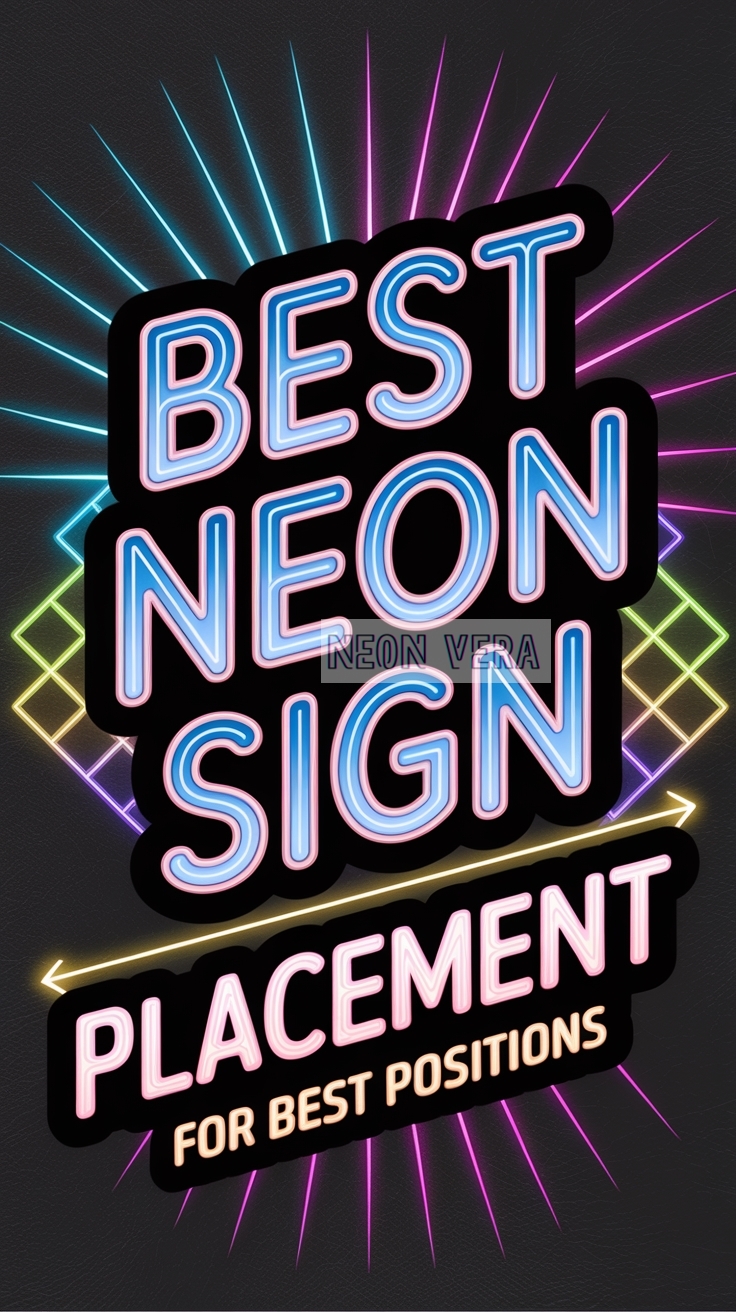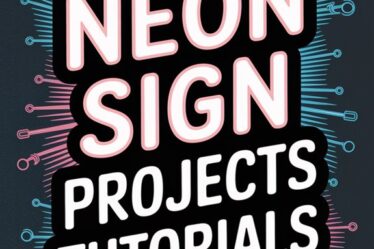
Place neon signs at eye level to maximize visibility and emotional impact without competing with nearby visuals.
Check the sign’s readability from different angles and distances, considering daytime and nighttime conditions.
Install signs in high-traffic areas and incorporate motion-activated features to enhance engagement.
Choose mounting surfaces that safely support the sign’s weight and allow hidden cable management. Strategic placement can increase foot traffic by up to 40%.
Strategic Placement Guidelines
You’ll need to carefully weigh indoor versus outdoor placement options, as each environment presents unique challenges for neon sign durability and maintenance.
To maximize visibility, consider factors like viewing angles, ambient lighting conditions, and potential obstructions that could impact your sign’s effectiveness.
Your sign’s placement can trigger specific psychological responses, so position it where it’ll create the desired emotional impact while guiding customer attention to key areas.
Indoor vs. Outdoor Considerations
When choosing between indoor and outdoor placement for neon signs, several key factors will determine the best location for maximum impact.
Indoor lighting conditions offer more control over your sign’s visibility and allow for subtler effects, while outdoor placement requires careful consideration of climate resilience and durability against weather elements.
Indoor signs should complement your decor while remaining visible from strategic viewing angles.
Natural lighting and existing fixtures will affect how your neon display performs.
Outdoor installations need weatherproof housing and proper electrical protection, plus they must be bright enough to compete with sunlight.
You’ll also need to account for local regulations, which often have stricter requirements for outdoor signage than indoor displays.
Visibility Optimization
Strategic placement of neon signs demands careful attention to viewing angles and sight lines. Study visibility from multiple directions to ensure your sign attracts notice from key traffic areas.
Monitor placement across different lighting conditions for optimal day and night impact.
Take into account surrounding elements that might obstruct or enhance your sign’s impact. Trees, buildings, or competing signage can affect how well your message stands out.
Consider your target audience and their typical viewing positions – whether walking, driving, or viewing from specific spots.
Check sign appearance from various distances to determine ideal size and height placement. Text legibility varies significantly depending on distance and viewing perspective.
Psychological Impact
The psychological impact of neon sign placement extends far beyond simple visibility, influencing customer emotions and behavior through careful positioning. When deployed at eye level, neon signs trigger immediate emotional responses that naturally draw customers inside.
Consider color psychology when positioning signs – warm colors like red and orange at entrance points create excitement, while cool blues and greens in relaxation areas enhance mood.
Strategic height and angle affect branding power. Mounting signs slightly above eye level captures attention while remaining approachable.
Positioning complementary signs throughout your space creates a unified customer journey and intentional experience. This placement strategy optimizes each neon sign’s ability to enhance atmosphere.
Technical Considerations
When planning your neon sign installation, you’ll need to contemplate power outlet locations and how you’ll safely conceal electrical cables.
You must evaluate the structural integrity of mounting surfaces, ensuring they can support the sign’s weight and accommodate proper mounting hardware.
Weather exposure, temperature fluctuations, and humidity levels in your chosen location will impact your sign’s longevity and performance.
Power Access & Cable Management
Proper power access and cable management serve as critical foundations for any neon sign installation. When planning your sign’s location, identify nearby power sources and establish the most efficient cable routing path. Installing an additional outlet may be necessary if existing power access is distant.
To maintain a clean aesthetic, use concealment techniques like wire molding or cable raceways to hide unsightly cords. Ensure all wiring meets safety standards by keeping cables away from heat sources and moisture-prone areas.
Regular maintenance includes inspecting for frayed wires, loose connections, and confirming proper grounding. When routing cables through walls, use appropriate conduits and consult an electrician about local electrical code compliance.
Mounting Surfaces
Successful neon sign installation depends heavily on selecting appropriate mounting surfaces. You’ll need to evaluate both surface materials and mounting types to guarantee your sign’s longevity and safety. Different materials like brick, concrete, drywall, and wood each demand specific installation methods and hardware.
Consider your sign’s weight distribution when selecting mounting points. Heavy signs require robust brackets attached to structural supports, while lighter pieces may work with adhesive mounting. For drywall, always anchor mounts into studs or use proper wall anchors.
Metal surfaces may require special brackets to prevent electrical conductivity issues. Double-check that your chosen surface can support your sign’s weight and won’t be compromised by heat.
Some materials, like vinyl siding or thin plastics, aren’t suitable for neon installations due to their low heat tolerance and structural limitations.
Environmental Factors
Beyond selecting the right mounting surface, your neon sign’s environment plays a major role in its performance and longevity.
Consider lighting conditions that might affect visibility at different times of day, and adjust placement to maximize impact.
Weather protection is crucial – shield your sign from rain, snow, and harsh sunlight.
Analyze nearby structures to ensure your sign fits harmoniously while avoiding potential hazards or interference.
Be mindful of ambient noise from nearby mechanical equipment, as it can affect the sign’s transformer performance.
Consider how surrounding surfaces interact with your sign’s illumination. Reflective materials like glass and metal can create glare or alter your sign’s appearance.
Design-Driven Placement Tips
When planning your neon sign placement, you’ll want to contemplate the size and scale relative to the surrounding space to create maximum visual impact.
You can enhance readability by positioning your sign at eye level and maintaining adequate spacing between letters and design elements.
For seamless aesthetic integration, match your sign’s color palette and style to complement existing decor while ensuring it remains a focal point.
Size and Scale
The right size and scale of your neon sign can make or break its visual impact in any space. When selecting dimensions, consider both room measurements and viewing distance. A well-proportioned sign should take up roughly 20-30% of its intended wall space.
Balance your neon sign with surrounding furniture and artwork by maintaining adequate negative space. Larger rooms allow for bigger signs, but maintain harmony with the architectural elements.
While size matters, strategic placement of a smaller sign often creates more impact than overwhelming dimensions.
Readability Enhancements
Making your neon sign readable requires smart placement that considers viewing angles and lighting conditions.
To optimize visibility, select fonts that stay clear at different distances, avoiding ornate or thin styles that blur when lit.
Pay attention to ambient light changes throughout the day, as brightness levels affect your sign’s impact. Avoid areas where competing light sources diminish the display.
Keep letters well-spaced to maintain definition, and choose mounting spots with clean backgrounds. Mount your sign perpendicular to where viewers will look.
Aesthetic Integration
Successful aesthetic integration demands a thoughtful balance between your neon sign and its surroundings.
Consider your space’s existing aesthetic themes when selecting placement – your sign should complement rather than clash with the overall design vision.
Match or contrast your neon colors with the ambient palette to create visual harmony.
Pay attention to spatial balance by positioning your sign to flow naturally with other elements.
Natural and artificial lighting changes throughout the day will affect your sign’s visibility and atmosphere.
Make your neon an artistic statement while ensuring it enhances the space.
Position it thoughtfully to create an engaging focal point that maintains design harmony with its environment.
Common Mistakes to Avoid
When installing neon signs, businesses often rush the process and make costly mistakes that diminish their signs’ impact and longevity.
Poor alignment creates an unprofessional look that detracts from your message. Placing neon signs amid too many visual elements creates clutter and reduces their impact.
Watch for inadequate contrast between your sign and its background, which can make it difficult to read from a distance. Bright signs can clash with sophisticated settings, disrupting the intended atmosphere.
Finally, overlooking regulations can result in fines or forced removal – always check local ordinances regarding size, brightness, and placement before installation.
Case Studies: Effective Placements
Real businesses have mastered neon sign placement through strategic vision and careful execution.
The Empire Diner in New York saw 40% higher foot traffic after moving their rooftop sign to eye level, aligning with pedestrian sight lines.
At Seattle’s Pike Place Fish Market, motion-activated neon signs follow customer paths, boosting brand visibility and increasing sales by 25%.
Chicago’s Jazz Club enhanced their entrance with strategically placed neon, lifting customer engagement by 35%. Their animated musical notes in neon draw nightly crowds, transforming the signage into an architectural feature.
Conclusion
Strategic neon sign placement can transform any space when following these proven guidelines.
By balancing visibility angles, power access, and design harmony while avoiding mistakes, you can achieve stunning visual impact.
Whether for a storefront or interior display, smart positioning enhances your neon sign’s power to attract attention and elevate aesthetics.


